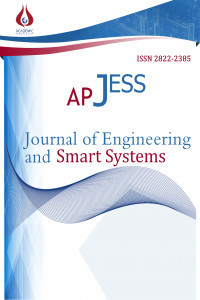Açık Alandaki Saksılı Bitkilerin Kapillar Yöntem İle Sulanmasında İletim Materyali Genişlik ve Sayılarının Su Tüketimi Üzerine Etkileri
Araştırma Karabük Üniversitesi Eskipazar Meslek Yüksekokulu uygulama bahçesinde 2011 yılında yürütülmüştür. Çalışmada % 100 Polipropilen mikro fiber malzeme su iletim materyali olarak kullanılmıştır. Eşit uzunluk (37 cm) ve kalınlıklardaki (1.8 mm) su iletim materyalleri iki farklı genişlik (3 ve 5 cm) ve iki farklı sayıda (saksının ortasında bir ve 40 cm aralıkta iki adet) kullanılarak su tüketimi üzerine etkileri araştırılmıştır. Çalışmada su iletim materyallerinin bir ucu 18x80x16 cm ebatlarında balkon tipi saksılar içerisine diğer ucu ise 5 litrelik su bidonlarının tabanına temas edecek şekilde yerleştirilmiştir. Saksılar orman toprağı ile doldurulduktan sonra her saksıda 3 bitki olacak şekilde aromas yediveren çilek fideleri dikilmiştir. Araştırma "tesadüf parselleri faktöriyel deneme planına" göre üç tekerrürlü olarak dizayn edilmiştir. Elde edilen sonuçlara göre hem tekli hem çiftli su iletim materyallerinin kullanıldığı saksılarda materyal genişliğinin su tüketimini önemli ölçüde etkilemediği görülmüştür (tekli-geniş 3.05 lt, tekli-dar 2.77 lt ve çiftli-geniş 8.5 lt, çiftli-dar 9.0 lt). Su iletim materyal sayısı su tüketimini önemli ölçüde etkilemiştir (tekli 2.77 lt ve çiftli 8.75 lt). Açık alandaki saksılı bitkilerin kapillar yöntem ile sulanmasında iletim materyali sayısı arttırılmalı ve farklı toprak yapısı araştırmalara dahil edilmelidir.
Anahtar Kelimeler:
Saksılı bitkiler, kapillar sulama, mikro fiber su iletim materyali.
Effects of Water Transmission Material Width and Number's on Water Consumption in Irrigation of Pot Plants with Capillary Irrigation Method at Open Field
This study was conducted at Karabuk University of Eskipazar Vocational School's research fields in 2011. In the study 100 % polypropylene micro-fiber material is used as the transmission of water. Equal length (37 cm) and thickness (1.8 mm) water transfer materials were used in two different widths (3 and 5 cm) and two different numbers (in the middle of the pot and two numbers with 40 cm interval) to investigate of the effects on water consumption. In the study, one end of the water transmission materials were placed into the balcony type 18x80x16 cm pots the other ends into the 5 liter plastic water containers. After each pots filled with forest soil were planted three aromas strawberry plants. Research has been designed according to" factorial complete randomized design" with three replications.According to results, width of the water transmission material not effected significantly on water consumption of pots which used both single and double water transmission material (single-wide 3.05 lt, single-narrow 2.77 lt and double-wide 8.5 lt, double-narrow 9.0 lt). Water consumption was effected significantly from the number of water transmission materials (single 2.77 lt and double 8.75 lt).Increased number of water transmission material should be use in open field capillary irrigation of potted plants and the next researchs include different soil textures.
___
- M. Karaşahin, “Saksılı bitkilerin açık alanda kapillar yöntem ile sulanmasında su iletim materyali sayısı ve toprak yapısının su tüketimi üzerine etkileri” HR.Ü.Z.F.Dergisi, 15(4), 1-8 (2011).
- P. B. Charlesworth, “Investigation of the efficiency and long term performance of various sub-surface irrigation configurations under field conditions”, Ph. D. Thesis, Charles Sturt University, New South Wales, (2003). [3] V. Devasirvatham, “Improved
- lettuce establishment by subsurface drip irrigation”, M. Sci. Thesis, University of Western Sydney, Australia, (2008).
- J. Toth, E. J. Nurthen and K.Y. Chan, “A simple wick method for watering potted plants which maintains a chosen moisture regime”, Australian Journal of Experimental Agriculture, 28, 805-808 (1988).
- J.M. Dole, C.J. Cole and S.L. Broembsen, “Growth of poinsettias nutrient leaching and water- use efficiency respond to irrigation methods”, Hort Science, 29, 858-864 (1994).
- J. Million, T. Yeager and C. Lanser, “Water use and fertilizer response of azalea using several no- leach irrigation methods”, Hort Technology, 17, 21- 25 (2007).
- M.O. Myung, Y.C. Young, S.K. Kee and E.S. Jung, “Comparisons of water content of growing media and growth of potted kalanchoe among nutrient-flow wick culture and other irrigation systems”, Hort Technology, 17, 62-66 (2007).
- M.K. Meriç and G.B. Öztekin, “Topraksız tarımda kapilar sistemler”, Ege Ü. Ziraat Fak. Dergisi, 45, 145-152 (2008).
- Yayın Aralığı: Yılda 3 Sayı
- Başlangıç: 2022
- Yayıncı: Akademik Perspektif Derneği
Sayıdaki Diğer Makaleler
Mohamed Sayed IBRAHİM, Hossieny Sameh Mohamed IBRAHİM, Moustafa Mohamed KAMAL, Yassin Mohamed TEMERK
Abdullah UZUN, Rüstem KELEŞ, İbrahim BAL
Ahmet GANİ, Hasan Rıza ÖZÇALIK, Hakan AÇIKGÖZ, Ö.fatih KEÇECİOĞLU, Erdal KILIÇ
Kontrolör Tasarımı için GA Kullanıldığı MATLAB ve.NET Tabanlı Bir Windows Uygulaması
Zeynep BATIK, Sezgin KAÇAR, Ünal ÇAVUŞOĞLU, Akif AKGÜL, Abdullah SEVİN
